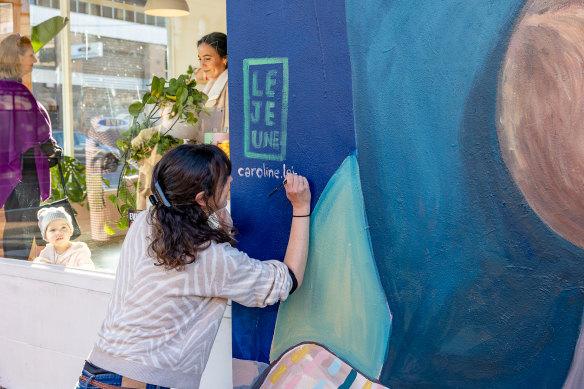
Tommee Tippee’s brand manager, Linda Simoni, said the banning was “disappointing” and reflective of the type of gender-based stigma the mural set out to overcome.
“It’s time for society to stop stigmatising breastfeeding and censoring the female form – be it art, or in person,” Simoni said.
According to Instagram’s community guidelines, nudity – including exposure of the female nipple – is not permitted on the platform for a “variety of reasons”. However, in 2015, imagery of breastfeeding and health-related situations (such as post-mastectomy and breast cancer awareness) were made exceptions to the rule. Instagram now also allows posts related to birth-giving, after-birth moments and gender confirmation surgery.
“Nudity in photos of paintings and sculptures is OK, too,” the platform states in its guidelines.
As a painting depicting breastfeeding, Breastralia should be exempt from any policies against nudity. The Age sought an explanation for the content’s removal from Instagram (through its parent company Meta), but the company did not wish to provide comment.
Lejeune is especially frustrated about the content’s speedy removal when compared to the management of Tommy Lee’s controversial photo in August. Lee’s post showed not only his nipples, but also his penis. The image remained online for at least five hours, receiving more than 50,000 likes and numerous comments from followers, including pornography site PornHub.
Loading
“It’s a painful comparison that reminds us how the censorship and moderation of women’s bodies online is prioritised over men’s,” Lejeune said.
This is not the first time Meta has been criticised over its lack of a streamlined and equitable policy regarding nudity.
There has been a long-standing campaign to #FreeTheNipple, with both artists and celebrities calling on Instagram and Facebook to drop the ban of female nipples completely.
And in October 2020, Facebook’s Oversight Board – established to uphold freedom of expression and to monitor the platform’s automated moderation – accused the platform of using inaccurate automation to censor images of women’s bodies after a user in Brazil posted a picture showing breast cancer symptoms.
Facebook removed the picture because it contained female nipples, even though its context (breast cancer awareness) should have made it exempt from their nudity policy.
“As Facebook’s rules treat male and female nipples differently, using inaccurate automation to enforce these rules disproportionately affects women’s freedom of expression,” the board concluded.

Caroline Lejeune adding the finishing touches to her mural in Collingwood.Credit:Kim Jane Photography
Reflecting on her own case, Lejeune said she would like to see artificial intelligence “develop in a way that removes gender bias, and monitors social media platforms equally and fairly”.
But, as observed in research conducted by Tommee Tippee, the issue isn’t confined to the internet.
Loading
Though discriminating against someone for breastfeeding and child-rearing is illegal, 46 per cent of the Australian mums surveyed by the company said feeding negatively impacted their self-confidence, 74 per cent felt generally overlooked, and 66 per cent thought society belittled them as new mothers.
As a new mum, former Collingwood AFLW player Moana Hope understands these pressures. But she believes public artwork like Breastralia can help shake society’s judgmental gaze.
“As women, we’re constantly told to cover up or judged for how, where, when and even for how long we choose to feed,” she said. “What I love about this piece is that – aside from being in Collingwood, which holds a special place in my heart for obvious reasons – it’s just so real and honest. I’d love to see more monuments to motherhood like this in public spaces.”
Lejeune said she wants Breastralia to be seen as a “battle cry for women”: “I hope that by contributing emotive and inclusive pieces of art that celebrate and spotlight women, with or without a child, it will assist in normalising women’s bodies in society.”
A cultural guide to going out and loving your city. Sign up to our Culture Fix newsletter here.



























